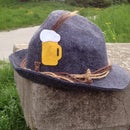Introduction: Voicetron - Voice Recording Toy
This device was created for pleasure and inspiration for anyone who would like to make a simple voice recorder for their children to play, or as a decoration, or use in Geocaching or in escape rooms. There are many possibilities. So let's get to it.
Step 1: Concept
Let's start with the toy concept. The device must include a microphone, loudspeaker, recording module, a switch and control buttons, and some decorative elements. All in a battery-powered box. I decided to use the ISD 1820 module, cheap and easy to find on ebay. The 9 volt battery needs an intermediate circuit, which will be a simple dc-dc converter to 5V. The second figure outlines two variants of the arrangement of individual components and parts.
Step 2: Tools You Need
- 1x ISD1820
- 1x 9 Volt battery
- 2x Push button
- 1x Toggle switch
- 1x DC-DC converter
- 9 Volt battery clip
- 1x 47ohm resistor
- 1x 470k ohm resistor
- 1x 2n3904 npn transistor
- 1x 5V Light bulb
- 24 Awg stranded wires
- Heat shrink tubes
- Soldering Iron
- Soldering solder
- Cutting pliers
- Needle nose pliers
- Cutting pliers
- Acrylic paints (silver, brass / copper)
- Screwdriver
- Multimeter
Step 3: Choosing a Speaker Box
I decided to use an old speaker, which lay unused for a long time. Its dimensions seemed satisfactory and it was also quite robust. Features a built-in speaker and front metal mesh.
Step 4: Microphone Tube
I liked the idea of placing the microphone in a long, flexible tube that could be shaped as needed. I got inspiration in the dollar-store when I saw this lighter. I disassembled it and kept the metal flexible part and also the metal cylinder that formed the end of the lighter.
Step 5: Light Bulb Socket
I made a socket for a light bulb with a piece of copper wire. I wrapped it around the thread of the bulb and then pressed it with pliers a little to make a good conductive contact.
Step 6: Ornaments
I created the ornaments using a 3D printer. I wanted to achieve a slight steampunk touch, so on the one side I created a hole for a switch and a slot for a decorative fuse and on the other I formed something resembling a tank, which will later be connected by a spiral coil with a recording button.
The recording button will be secured with a cage to prevent unwanted recording.
The upper part will contain holes for a light bulb, a microphone tube, a small antenna and one push button. The bulb will be placed inside the protective cage.
Step 7: Coloring the Box
I used copper acrylic spray to paint the box. The spray creates a uniform color that is suitable for smooth and larger surfaces. Ornaments printed on a 3D printer will be colored with a brush. The front part is covered with masking tape to keep its original color.
I applied more coats as I touched the non-dried paint too soon and ruined the first coat. In some places, the paint was also sprayed unevenly.
Step 8: Coloring the Pipe
I first covered the shiny part of the flexible tube from the lighter with masking tape. Subsequently, I sprayed both ends with matt acrylic black paint and then applied lacquer.
Step 9: Drilling Holes
Before drilling the holes, I unfolded the printed parts on the appropriate sides and arranged them so that I was aesthetically pleased with them. Subsequently, I marked the holes to be drilled and drilled them with a step drill bit and a small drill.
Step 10: Placing Components Inside the Box
The inside of the box is large enough for a 9 V battery, which I placed in the upper corner and placed the printed circuit boards on the back cover. I fastened them with the help of spacers, which I attached to the cover with the help of a hot air gun.
The remaining empty space of the box will be filled with wires.
Step 11: Mounting Push Buttons
I screwed in both buttons and soldered one pair of their legs together, which will be connected as a common anode.
Step 12: Wiring Push Buttons
First, I treated the contacts with rosin, for better adhesion of the soldering solder. I used a yellow wire for the common anode and blue wires for recording and playback. After soldering, I secured them with a tube and then twisted them to make them easier to handle.
Step 13: Wiring the Switch
The switch serves as the main switch. It allows current to flow from a 9 V battery to a DCdc converter.
When it is turned off, we will not spend any energy even on the standby run of the converter.
Step 14: Preparing Wires for the Microphone
It is necessary to prepare wires for the microphone. These will later run along the entire flexible tube, so they need to be a little longer.
Step 15: Preparing Wires for the Light Bulb
The socket of the bulb will be inserted through the 3d ornament in a later step, so we will also prepare the wires in advance.
Step 16: Wiring the DCDC Converter
Solder the red wire leading from the switch to the + terminal and the black wire directly from the 9 V battery clip to the - terminal of the DCDC converter. I tinned the contacts first to make better contact.
Step 17: Adjusting DCDC Converter Output Voltage
To set the output voltage of the DCDC converter, we will need a multimeter. After connecting the battery and turning on the switch, we measure the output of the converter. With the help of a small screwdriver, we turn the trimmer (try both sides) and thus adjust the output voltage to a value of about 5 V.
Step 18: Sample Rate of the Recording Module
The datasheet of the ISD1820 module tells us that the resistor connected from the Rosc pin (pin 10) to ground defines the sampling rate of the recording. With higher sampling, the recording time shortens, but its quality is higher.
Step 19: Changing Sample Rate of the Recording Module
In this step, we adjust the default value given by the manufacturer, which is 100k ohm (resulting in 10 sec recording duration and 6.4 kHz sampling rate), to a value of approximately 80k ohm. This achieves an 8 kHz sampling rate, ie higher sound quality. To change the value of the 100 k ohm resistor, add a 470 k ohm resistor in parallel.
Step 20: Adding Transistor for Light Bulb
We need to add a transistor that will work as a light bulb switch. First, connect the emitter of transistor 2n3904 to ground. Then we connect a 47 ohm resistor between the positive speaker pin (red) and the base of the transistor. The bulb will be connected later between Vcc terminal (5 V) and the collector of the transistor as shown in the figure.
Step 21: Conecting DCDC Converter to Sound Module
We will connect the output from the dcdc converter to the input ISD1820. It is possible to solder the wires to the front directly to the connector or to the back side of the pcb.
Step 22: Removing the Microphone From the Module
We need to remove the microphone soldered directly to the module so that we can later insert it into the flexible tube. Before desoldering, I first treated the contacts with resin. Subsequently, I soldered two wires to the terminals where the microphone was, which I had prepared before.
Step 23: Connecting Buttons With the Module
Connect the wires leading from the buttons, the common anode (yellow) to the Vcc terminal (5 V) and one wire to the REC button, the other to the PLAYE button (both are blue).
Step 24: Connecting Light Bulb to the Module
I connected two wires (white & brown) between the positive terminal of the Vcc and the collector of the transistor, which will later lead to the bulb. Polarity of the bulb does not matter.
Step 25: Sanding 3d Printed Parts
Depending on the print quality of your printer, you may or may not have to sand decorative parts. For sanding, I used a set of files and also a small grinder.
I used the cutter to remove excess printing defects (like stringing).
Step 26: Coloring 3d Printed Parts
I wanted the toy to have a steampunk touch, so I decided to paint the ornaments in silver. You can use an antique hobby paint or a regular acrylic spray paint. I sprayed a little acrylic paint into the lid and painted the parts by hand with a brush, for more detail.
Step 27: Gluing 3d Printed Parts to the Box
After the printed parts had dried, I glued them to the surfaces of the box with a quick-drying glue.
Step 28: Connecting the Microphone
I pushed the longer pre-prepared cable through the flexible tube and soldered the microphone to the end, secured with tubes.
Step 29: Microphone Mount
To attach the microphone, I applied a little glue and then put the original lighter cover on the flexible tube. The masking tape will be removed at the end to avoid scratching the paint.
Step 30: Light Bulb Mounting
Before soldering the bulb, I sanded the inside of the socket to make good conductive contact. I also ground the end of the copper wire of the sleeve so that it could be soldered.
Then I connected the wires leading from the module (brown and white) to the light bulb (polarity doesn't matter).
Step 31: Hot Gluing
Those parts that will be exposed to mechanical stress (flexible tube with a microphone, switch and, for sure, a light bulb on which there will be a cover later), I secured with the help of hot glue.
Step 32: Mounting Metal Mesh Cover
I attached the metal grid, which was removed at the beginning, back to the box in this step. It is fixed with small bent handles inside the box.
Step 33: Inserting Battery and Closing the Back Cover
The wires inside the box, I pushed into one corner. A 9 V battery was placed in the other corner.
closing the back cover. Twisted cables help with handling and do not fly everywhere.
Step 34: Mounting Protective Cage for the Recording Button
I installed a protective cage for the REC button, which will have a functional (prevent unwanted recording), but also an aesthetic function.
Step 35: Mounting Light Bulb Cage
In this step, I mounted a protective cage for the bulb. The cage is secured in the thread with a piece of bent wire.
Step 36: Inserting Decorative Fuse
On the ornament located on the right, I inserted a fuse. The fuse holds firmly in the holder and therefore I did not use glue.
Step 37: Inserting Decorative Antenna
I placed an old needle from the bicycle pump on the ornament placed on top. I secured it with hot glue.
Step 38: Creating and Installing a Decorative Coil
On the ornament on the right, I wanted to attach a coiled wire in the shape of a coil. I formed it with a marker, around which I wrapped a few turns of copper wire, and then with the help of pliers I bent the beginning and end so that they could be inserted into the holes on the ornament.
Step 39: Finished Project
Finally, the project is completed and ready for use in games, geocaching, escape rooms or recording for fun.
Step 40: Some Additional Photos. Thank You for Your Time.
I'm adding a few extra photos.
If you have any questions, do not hesitate to contact me.
If you like the project, I will be happy if you vote for it. Thanks for reviewing.
Stay healthy and safe :)

Participated in the
Toys and Games Challenge


















